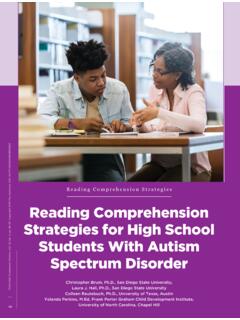Transcription of Understanding the Big Five for the Early or Struggling Reader
1 reading AFTER EPILEPSY SURGERY An Introductory Series for Parents and Educators Part 1 Understanding THE BIG five FOR THE Early OR Struggling Reader INTRODUCTION In today s world, reading is the key to independence . reading entertains you when you re bored, keeps you company when you re lonely, and opens up a world of knowledge when you re curious. Through the teen years and into adulthood, reading connects you to friends and family as you text back and forth, helps you order your favorite meal from a menu, and gets you on the right bus on your way to an appointment.
2 reading makes it possible to have a job, understand the lease agreement for your new apartment, and follow directions on a bottle of prescription medication. It s clear that reading touches nearly every aspect of our daily lives and is arguably the most important skill your child will need in their lifetime. Children who have reading difficulties have a higher school dropout rate, are at greater risk of unemployment, achieve lower income levels in adulthood, and struggle with feelings of low self-esteem and adjustment.
3 This is why it s so 1important for a child to learn how to read. Unlike learning how to walk or talk, reading doesn't come naturally to children it must be taught! Unfortunately, children with epilepsy have a much higher rate of reading difficulties when compared to the general population. If the epilepsy is drug resistant, the seizures interfere with 2knowledge and skill acquisition. Epilepsy surgery can also negatively impact a child s reading development in many ways. Because reading involves several different areas of the brain working together, removing or disconnecting parts of the brain can contribute to poor reading development.
4 For example, children who have had the occipital lobe removed or disconnected (such as after hemispherectomy, temporal lobe resection, or posterior quadrantic resection also known as TPO ) will have vision challenges that make it difficult to see a whole world. Removing a temporal lobe results in auditory challenges which can make it difficult to figure out the sounds letters make. Intellectual impairments or memory deficits can also making reading difficult. In this guide, we will review the basics of reading to help you understand what s important.
5 Subsequent guides in this series will discuss how the basics of reading relate to a child who has had epilepsy surgery, the unique obstacles they face on the road to reading , and how to make a plan to overcome them. Starting Early , with proper assessment, intervention, and a thorough Understanding of the obstacles to reading , most children after epilepsy surgery have a chance to become literate. 1 Patil M, Saraswathi G, Padakannaya P. Self-esteem and Adjustment among Children with reading and Writing Difficulties. Stud Home Comm Sci 2009; 3(2): 91-95 2 Fastenau PS, Jianzhao S, Dunn DW, Austin JK.
6 Academic underachievement among children with epilepsy: proportion exceeding psychometric criteria for learning disability and associated risk factors. J Learn Disabil 2008;41: 195 207. _____ reading AFTER EPILEPSY SURGERY1 An Introductory Series for Parents and Educators THE BASICS OF reading While our brains are naturally wired for spoken language, reading is not a natural process like walking or talking. reading must be taught explicitly and formally in order to be acquired. This is 3because reading is a relatively new development in human history in fact, it is only in the last hundred years that a majority of the world s population could be called literate.
7 reading is a complicated process, involving our vision, hearing, and several areas of our brain working together quickly to make sense of written words. While different regions of the brain do have specialized functions, it s important to remember that the brain is really a complicated network of pathways involving the eyes, ears, and both sides of the brain. If disrupted, these broken pathways can lead to reading challenges. The Big five Of reading reading is broken down into five main areas: phonemic awareness , phonics , fluency , vocabulary , and comprehension.
8 According to the National reading Panel, it s important to understand these 4different parts of reading and how they work together. Here, we ll use the word shop to explain the five main components of reading . 3 Gabrieli, J., Christodoulou J, O Loughlin, T, Eddy, M. (2010) "The reading Brain In: Mind, Brain, and Education. 1st Ed. Bloomington: Solution Tree Press; p. 113. 4 National reading Panel ( ), & National Institute of Child Health and Human Development ( ). (2000). Report of the National reading Panel: Teaching children to read : an evidence-based assessment of the scientific research literature on reading and its implications for reading instruction : reports of the subgroups.
9 Washington, : National Institute of Child Health and Human Development, National Institutes of Health. _____ reading AFTER EPILEPSY SURGERY2 An Introductory Series for Parents and Educators Phonemic awareness _____ While we use our eyes to read, the true starting point for reading is sound . The child must learn to connect what she hears and says to the written letter on the page. This ability to notice, think about, and work with the individual sounds in words is called phonemic awareness . It s the knowledge that sounds of spoken language make words.
10 Phonemic awareness is 100% auditory , meaning it is only related to the sounds a letter makes, or the sounds letters make together in a word. Phonemic awareness has nothing to do with written letters or words. According to the National reading Panel, teaching phonemic awareness to children significantly improves their reading . For this reason, it s critical that a child learning to read receives explicit and systematic phonemic awareness instruction . Phonemes - The Sounds of Language A phoneme is an individual sound in a spoken word.







